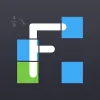Take a look inside 5 images
Fraction Mash
Pros: Ridiculous photo mash-ups are a kid favorite, controls are simple, fraction presentation is easy to understand, and extra options add depth.
Cons: Actual fraction content is pretty limited, and lining up faces and other photos can be tedious and frustrating.
Bottom Line: Math-flavored goofy fun is great for casual exposure to fractions, but will need thoughtful integration if used as a dedicated learning tool.
Fraction Mash is a great learning toy for meaningful exploration time during any fraction unit in elementary or middle school. Give kids some unstructured time to play around and create their own mash-ups, then ask each student or group to do some mathematical reflection and justification to bring the lesson back to fractions. You can also provide images that might be relevant to your school or content from other classes for some interdisciplinary flavor. It's also not a bad idea to keep Fraction Mash around as an option to keep kids meaningfully occupied during standardized testing downtime or other lost classroom time.
If you need more structure to get started, check out NYCSI's website for a bunch of thoughtfully prepared lesson plans and ideas or teacher-submitted tips, ideas, and inspirations.
Fraction Mash is a math-inflected version of the now ubiquitous face-mash-up apps. Students combine two images by dividing each into equal parts using a variety of division schemes, then select which parts of each image to keep. The resulting mash-up is then displayed, and edges can be blurred to seamlessly blend the two images. Ridiculous combinations of faces, animals, shapes, abstract designs, or almost anything else can be made. Along the way, the selected fractions of each image are displayed as an addition problem, and students can directly change the numerators and denominators of each to see how this affects the image.
The app also features a built-in reflection tool in which students can choose from a variety of templates and insert images or videos. The tool also lets students write about their creations, either as part of a formal unit or for a final presentation or report.
There are three ways that Fraction Mash is great for student learning. First, it uses creative play to keep kids engaged in tinkering, remixing, and exploring, which helps to build curiosity and persistence. Second, it promotes student agency by giving kids a choice about which images to use and how to combine them. Third, it presents fractions as partitions of a whole and keeps the notion of unity at the core of its pedagogy. This strategy has been used by successful learning programs such as Montessori and Waldorf schools for decades because it's such an intuitive way to grapple with numerators and denominators. Ultimately, it would have been nice to see some extensions to the math concepts, such as mixed denominators, subtraction, or fractions that add to less than or more than one. These would be fairly easy to implement but would add a lot to the learning potential.
Ultimately, it would have been nice to see some extensions to the math concepts, such as mixed denominators, subtraction, or fractions that add to less than or more than one. These would be fairly easy to implement but would add a lot to the learning potential.














